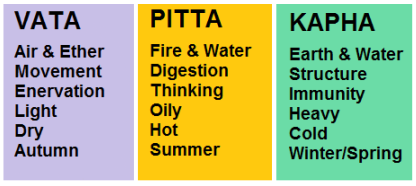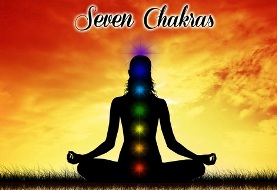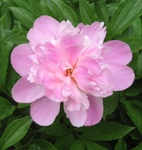THE BASIC PRINCIPLES OF AYURVEDA
How Do They Apply to Individual Health?
 Ayurveda is considered by many scholars to be the oldest healing science in the world.
It is a holistic approach to health that helps people live long, healthy, and well-balanced
lives, and is recognized in the West today as a form of complementary and alternative medicine.
The basic principle of Ayurveda is to prevent and alleviate illness by maintaining balance in
the body, mind, and consciousness through proper intake of fluids, appropriate diet and lifestyle,
and herbal remedies. It incorporates the concepts of the three "doshas" and of the seven "chakras."
Ayurveda is considered by many scholars to be the oldest healing science in the world.
It is a holistic approach to health that helps people live long, healthy, and well-balanced
lives, and is recognized in the West today as a form of complementary and alternative medicine.
The basic principle of Ayurveda is to prevent and alleviate illness by maintaining balance in
the body, mind, and consciousness through proper intake of fluids, appropriate diet and lifestyle,
and herbal remedies. It incorporates the concepts of the three "doshas" and of the seven "chakras."
Ayurveda describes three fundamental energies that govern our inner and outer environments:
• MOVEMENT • TRANSFORMATION • STRUCTURE
The Sanskrit terms for these three elements, or "doshas," are:
• VATA (wind) • PITTA (fire) • KAPHA (earth)
According to Ayurveda, there are FIVE master elements or "panch mahabhutas" that make up
everything within our bodies and everything outside of our bodies. The five elements are space (ether),
air, fire, water, and earth. Space carries all the aspects of pure potentiality or infinite possibilities;
air has the qualities of movement and change; fire is hot, direct, and transformational; water is cohesive
and protective; and earth is solid, grounded, and stable. These five master elements combine in different
ways to create the THREE doshas.
The three doshas are responsible for the general characteristics of our mind and body - our constitution
- which in Ayurvada is called our "dosha prakriti." Each of us has all three doshas in our constitution,
in a proportion unique to each individual; some have Vata predominating, some have Pitta most dominant,
and some have Kapha.
 IN BALANCE, one's prevailing dosha may manifest as follows:
IN BALANCE, one's prevailing dosha may manifest as follows:
Vata: Light, thin frame; energetic, joyous, quick-thinking, strong communicator
Pitta: Medium build, light hair and eyes; passionate, intelligent, courageous
Kapha: Heavy set, thick, oily skin; steady, motherly, methodical, thoughtful
OUT OF BALANCE, one's prevailing dosha may manifest as follows:
Vata: Anxiety, gas/bloating/constipation, forgetfulness, restlessness
Pitta: Irritability or anger, rashes, diarrhea, being critical and controlling
Kapha:Depression, weight gain, mucous build-up, difficulty waking, complacency
• Vata-predominant • Pitta-predominant • Kapha-predominant •
• Three dual Prakritis, where two doshas are equally, or nearly equally predominant:
Vata-Pitta predominant • Pitta-Kapha predominant • Vata-Kapha predominant •
• One Prakriti that has all three doshas equally prominent: Vata-Pitta-Kapha evenly predominant. •
A primary goal of Ayurvedic healing is to identify a person's ideal state of balance, determine where they are out of balance, and offer interventions using: diet, herbs, natural cleansing and detoxification, aromatherapy, massage therapy, and meditation to reestablish balance.


“Chakra” is a Sanskrit word meaning wheel, or vortex. Our energy system is composed of seven chakras ( energy centers). These energy centers function like valves or gateways, and regulate the flow of energy through our energy system. The functioning of the chakras reflects decisions we make concerning how we choose to respond to conditions in our life. We open and close these valves when we decide what to think, and what to feel, and through which perceptual filter we choose to experience the world around us.
The chakras are aspects of consciousness in the same way that auras are aspects of consciousness. The chakras are more dense than the auras, but not as dense as the physical body. They interact with the physical body through two major vehicles, the endocrine system and the nervous system. Each of the seven chakras is associated with one of the seven endocrine glands and also with a group of nerves called a plexus. Thus, each by the plexus or endocrine gland associated with that chakra.
All of your senses, your perceptions, and your possible states of awareness -- everything it is possible for you to experience -- can be divided into seven categories, each of which can be associated with a particular chakra. Thus, the chakras represent not only particular parts of your physical body, but also particular parts of your consciousness. When you feel tension in your consciousness, you feel it in the chakra associated with the part of your consciousness that is experiencing the stress, and in the parts of the physical body associated with that chakra. The tension or blockage in the chakra is detected by the nerves of the plexus associated with that chakra, and transmitted to the parts of the body controlled by that plexus; it may then manifest in the physical body in various forms of pain or disease.
rekhasharmawellness@gmail.com
The content of this website is provided for general informational purposes only
and is not intended as, nor should it be considered a substitute for, professional medical advice.
The statements have not been evaluated by the FDA.
The products are not intended to diagnose, treat, cure, or prevent any disease.
Please contact your professional healthcare provider if you have any medical problems.

